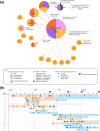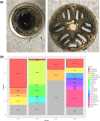Genomic surveillance, characterization and intervention of a polymicrobial multidrug-resistant outbreak in critical care
- PMID: 33599607
- PMCID: PMC8190620
- DOI: 10.1099/mgen.0.000530
Genomic surveillance, characterization and intervention of a polymicrobial multidrug-resistant outbreak in critical care
Abstract
Background. Infections caused by carbapenem-resistant Acinetobacter baumannii (CR-Ab) have become increasingly prevalent in clinical settings and often result in significant morbidity and mortality due to their multidrug resistance (MDR). Here we present an integrated whole-genome sequencing (WGS) response to a persistent CR-Ab outbreak in a Brisbane hospital between 2016-2018.Methods. A. baumannii, Klebsiella pneumoniae, Serratia marcescens and Pseudomonas aeruginosa isolates were sequenced using the Illumina platform primarily to establish isolate relationships based on core-genome SNPs, MLST and antimicrobial resistance gene profiles. Representative isolates were selected for PacBio sequencing. Environmental metagenomic sequencing with Illumina was used to detect persistence of the outbreak strain in the hospital.Results. In response to a suspected polymicrobial outbreak between May to August of 2016, 28 CR-Ab (and 21 other MDR Gram-negative bacilli) were collected from Intensive Care Unit and Burns Unit patients and sent for WGS with a 7 day turn-around time in clinical reporting. All CR-Ab were sequence type (ST)1050 (Pasteur ST2) and within 10 SNPs apart, indicative of an ongoing outbreak, and distinct from historical CR-Ab isolates from the same hospital. Possible transmission routes between patients were identified on the basis of CR-Ab and K. pneumoniae SNP profiles. Continued WGS surveillance between 2016 to 2018 enabled suspected outbreak cases to be refuted, but a resurgence of the outbreak CR-Ab mid-2018 in the Burns Unit prompted additional screening. Environmental metagenomic sequencing identified the hospital plumbing as a potential source. Replacement of the plumbing and routine drain maintenance resulted in rapid resolution of the secondary outbreak and significant risk reduction with no discernable transmission in the Burns Unit since.Conclusion. We implemented a comprehensive WGS and metagenomics investigation that resolved a persistent CR-Ab outbreak in a critical care setting.
Keywords: Acinetobacter baumannii; CR-Ab; WGS; burns ward; carbapenem resistance; genomics; intensive care unit; metagenomics; surveillance; whole-genome sequencing.
Conflict of interest statement
P.N.A.H. has received research grants from MSD and Shionogi Ltd, outside of the submitted work, and speaker’s fees from Pfizer paid to The University of Queensland. D.L.P. reports receiving grants and personal fees from Shionogi and Merck Sharp and Dohme and personal fees from Pfizer, Achaogen, AstraZeneca, Leo Pharmaceuticals, Bayer, GlaxoSmithKline, Cubist, Venatorx, and Accelerate. J.L. has received personal fees from Pfizer and MSD and grants from MSD paid to The University of Queensland. The other authors have no conflicts of interest to declare.
Figures





References
-
- Cruickshank MMC. Reducing Harm to Patients from Healthcare Associated Infections: an Australian Infection Prevention and Control Model for Acute Hospitals. Sydney: Australian Commission on Safety and Quality in Health Care; 2009.
Publication types
MeSH terms
Substances
LinkOut - more resources
Full Text Sources
Other Literature Sources
Medical

